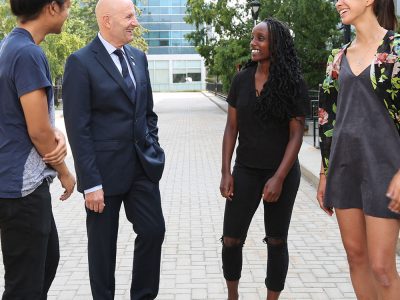By Juwaeriah Siddiqui
This article is republished from The Conversation under a Creative Commons licence. All photos provided by The Conversation from various sources.
Is the pandemic affecting children? We can only speculate because we are not asking them how the pandemic is affecting them.
We are choosing to view the pandemic-derived challenges surrounding childhood through an adult lens. In other words, we are re-inscribing western colonialist ideology on children, in the way we choose to understand their struggles and their need for education and socialization.
How we make decisions affecting children’s lives today is shaped by our social legacies. Can we change this narrative to consider the agency of children during the pandemic?
In the huge shuffle of lock downs, stay-at-home orders and travel bans, one constant issue has been the reopening of schools. Perhaps this could be considered a diligent consideration of children’s mental and physical well-being due to the lack of socialization and the relentless number of hours spent behind a screen.
I have been observing and writing about the social construction of childhood through my fieldwork with children, where I study their motivation to learn languages other than English.
Prioritizing education
Since when has the education and socialization of a child been given so much emphasis that it has been placed above the mental health of that very child?
For a moment let us take the child back to their safe space, their homes, and assess how we have shifted their meaning of safety and comfort to virtual interaction and forced listening. Take a look at young children — and not their parents — required to attend six hours of schooling through a screen. We hear from parents about how hard it is for their families to balance school and working from home.
But have we thought about the child — their agency and choice when it comes to learning? As adults, we understand six hours of online school learning is way more challenging than in school learning, yet we have enforced this transition on children without hearing from them. Despite knowing the challenges and despite the resistance from children, we have revisited — or rather, reinforced — the historical construction of children and their actual needs.
Virtual isolation
In my fieldwork, I hear from children about their feelings in the pandemic. “I usually feel lazy by the fourth hour,” one five-year-old who was required to attend school from home during the pandemic. Another child who had just started school said: “School is fun with friends, I still cannot talk to my friends.”
When we think of how schools made a transition to a virtual environment, we usually think of the curriculum, the classroom engagement level and the quality of teaching and learning. It is all about re-creating the ultimate learning experience at home. Yet, the connection with other children — the ability to bond, share and have fun with peers — was removed.
The emotional well-being of children was rarely if at all considered in the process of transferring knowledge. How else do you justify six hours of online learning?
The focus has always been on the success of the economy and on producing a skill set that can lend to it.
Today’s public schools serve as institutional spaces where children, who once worked in factories, could now have something valuable to do while their parents contributed to the economy. It serves as a way to keep children occupied while the adults take on economically productive tasks.
This notion is so deeply rooted in our ideologies of what education looks like and how it should be imparted that, even during a global crisis, public well-being is equated with economic well-being at the expense of a child. Our performance as a society is measured in terms of how quickly we can get them out of our common work spaces, to gain the preordained skill set, at the expense of the child’s well-being. If that means we intrude on their safe spaces, to educate them, we do! If that means we expect children as young as four to work on their devices as though they were young adults, we present that as modern-day schooling.
Centering children
Do we truly believe, as an advanced society in the current world, the only way a child can be educated is by spending the same number of hours in school at home learning? Are we saying that while businesses and governments can run on reduced capacity, our educational curriculum cannot be reduced given the pandemic?
Asking questions like these brings the child to the centre of the conversation, which doesn’t happen unless there is an adult’s interest at stake. It all boils down to how we view the role of children traditionally and how we can continue to keep them in institutionalized school systems.
As we think about their return to school, children have no voice in asking for reduced school hours, lesser workloads or the option of attending school during a pandemic. We continue to push the boundaries around children’s education without addressing their concerns or recognizing their agency. Instead, we choose to force them to adjust to a system of education that has not been built to truly serve children’s interests.
![]()
Tuesday, September 7, 2021 in The Conversation
Share: Twitter, Facebook



